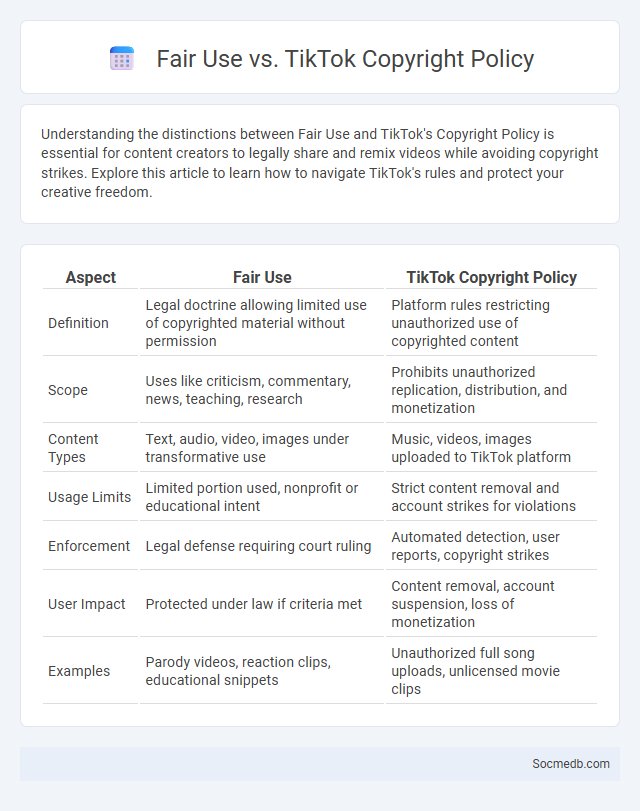
Photo illustration: Fair Use vs TikTok Copyright Policy
Understanding the distinctions between Fair Use and TikTok's Copyright Policy is essential for content creators to legally share and remix videos while avoiding copyright strikes. Explore this article to learn how to navigate TikTok's rules and protect your creative freedom.
Table of Comparison
| Aspect | Fair Use | TikTok Copyright Policy |
|---|---|---|
| Definition | Legal doctrine allowing limited use of copyrighted material without permission | Platform rules restricting unauthorized use of copyrighted content |
| Scope | Uses like criticism, commentary, news, teaching, research | Prohibits unauthorized replication, distribution, and monetization |
| Content Types | Text, audio, video, images under transformative use | Music, videos, images uploaded to TikTok platform |
| Usage Limits | Limited portion used, nonprofit or educational intent | Strict content removal and account strikes for violations |
| Enforcement | Legal defense requiring court ruling | Automated detection, user reports, copyright strikes |
| User Impact | Protected under law if criteria met | Content removal, account suspension, loss of monetization |
| Examples | Parody videos, reaction clips, educational snippets | Unauthorized full song uploads, unlicensed movie clips |
Understanding Fair Use: Key Principles
Understanding fair use is essential for navigating social media content legally and ethically, as it allows limited use of copyrighted material without permission under specific conditions. Key principles include purpose and character of use, nature of the copyrighted work, amount used, and the effect on the market value of the original. Your awareness of these factors helps protect you from infringement claims while enabling creative expression and content sharing.
Overview of TikTok Copyright Policy
TikTok's copyright policy emphasizes protecting creators' original content while enabling a safe sharing environment. The platform employs automated tools and manual reviews to detect copyright infringements, removing content that violates rights holders' claims. Users are encouraged to respect intellectual property by uploading only content they own or have permission to use, with repeat offenders facing account suspension or termination.
Sound Copyright: What Creators Need to Know
Sound copyright protects audio elements such as music, sound effects, and voice recordings, ensuring creators maintain exclusive rights to their original work. Your social media content must respect copyright laws to avoid penalties, content removal, or demonetization on platforms like YouTube, Instagram, and TikTok. Understanding licensing options and obtaining proper permissions helps secure your creative use of sound while preventing legal issues.
Distinguishing Fair Use and TikTok Guidelines
Understanding the distinction between Fair Use and TikTok Guidelines is crucial for content creators to avoid copyright infringement and platform penalties. Fair Use allows limited use of copyrighted material for commentary, criticism, or parody under U.S. law, but TikTok's community standards may impose stricter rules regarding copyrighted content. You must review TikTok's specific policies alongside Fair Use principles to ensure your videos comply with both legal and platform-specific requirements.
Common Copyright Issues on TikTok
Common copyright issues on TikTok frequently involve unauthorized use of music, videos, and images without proper licensing or attribution, leading to infringement claims. TikTok's content moderation system employs automated filters and manual takedowns to address violations, yet users often bypass these measures by uploading copyrighted material disguised or altered. Understanding and adhering to TikTok's copyright policies, including respecting Digital Millennium Copyright Act (DMCA) takedown requests, is essential for creators to avoid account suspension or legal repercussions.
Monetization and Sound Usage on TikTok
Maximizing monetization on TikTok involves leveraging your content's engagement through TikTok's Creator Fund, brand partnerships, and in-app purchases like coins and gifts. Utilizing trending sounds and original audio effectively increases your content's visibility, which is critical for expanding your audience and boosting revenue opportunities. Ensure you have the appropriate rights or permissions for any sound used to avoid copyright issues and maximize your earning potential.
How TikTok Handles Copyright Infringement
TikTok employs a robust copyright enforcement system that uses automated filters and manual reviews to detect and remove infringing content swiftly. The platform follows the Digital Millennium Copyright Act (DMCA) guidelines, allowing copyright holders to submit takedown requests that TikTok processes promptly to protect intellectual property rights. You can protect your content by understanding TikTok's copyright policies and reporting violations through their dedicated online tools.
Legal Consequences for Violating Sound Copyright
Violating sound copyright on social media can result in severe legal consequences, including hefty fines and potential lawsuits for unauthorized use of protected audio content. Platforms like YouTube and Instagram employ automated detection systems to identify and remove infringing material, often leading to account suspension or termination. Protecting your social media presence requires strict adherence to copyright laws and obtaining proper licenses before sharing any copyrighted sound.
Tips for Using Copyrighted Audio Legally
Using copyrighted audio legally on social media involves obtaining proper licenses or permissions from rights holders before posting. Employing royalty-free music platforms like Epidemic Sound or Artlist ensures compliance with copyright laws and avoids content takedowns. Properly attributing creators and understanding platform-specific audio usage policies, such as those on TikTok or Instagram, further reduces the risk of copyright infringement.
Future Trends in Social Media Copyright Enforcement
Future trends in social media copyright enforcement will increasingly leverage artificial intelligence and blockchain technology to detect and prevent unauthorized content sharing. Platforms are implementing advanced machine learning algorithms to monitor and analyze millions of posts in real-time, ensuring quicker identification of copyright infringements. You can expect tighter collaboration between content creators, legal entities, and social media companies to foster more transparent and efficient enforcement processes.
 socmedb.com
socmedb.com